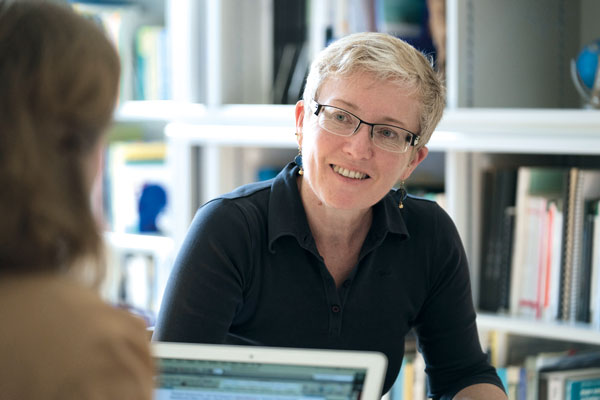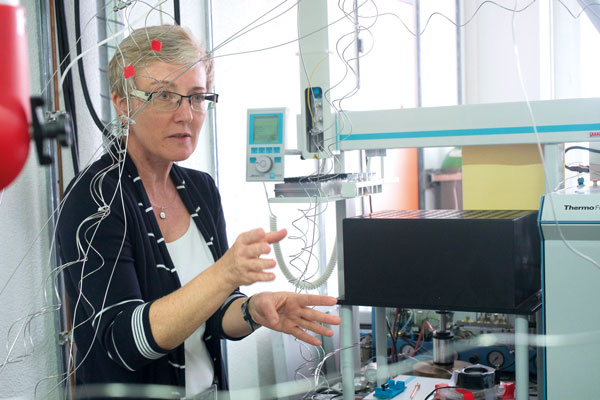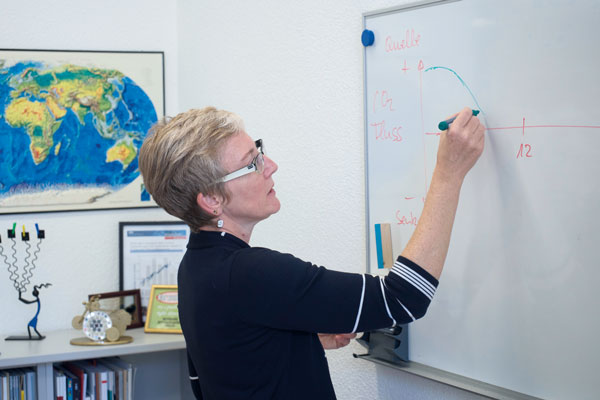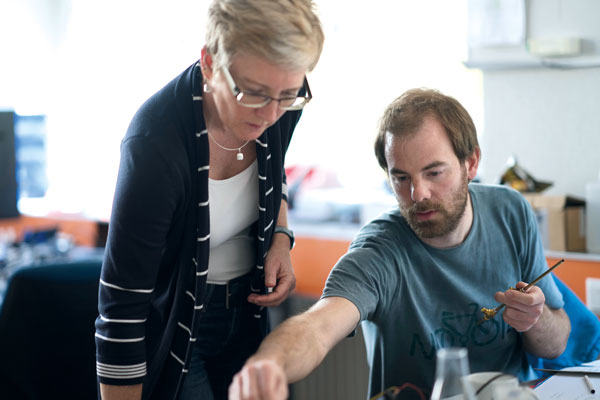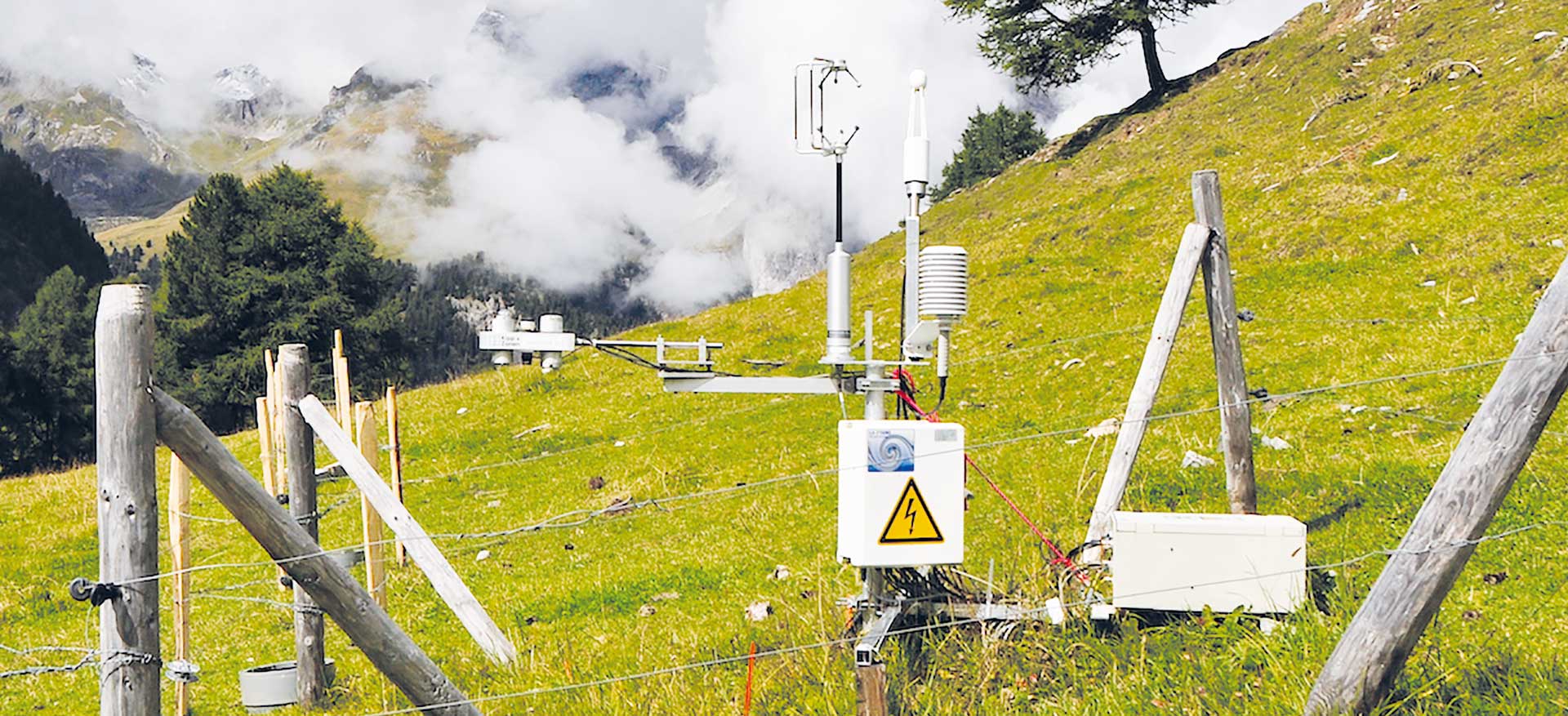
Agriculture: The driven and the driver of climate change
Flux measurements help to develop realistic climate models
Why the type of agriculture has a major influence on the environment and why Nina Buchmann’s research deals with two sides of the same coin.
Nina Buchmann’s work focuses on the effects of different forms of cultivation on climate and biological diversity and, conversely, on the reactions to climate change of ecosystems, plants and soils. The scientist’s rapid speech is impressive; she talks in dense sentences and without interruption. It quickly becomes evident that this researcher is not the dawdling type. Proof thereof are her comprehensive list of publications and the many international projects she is either actively involved in or has initiated herself, for example a multiannual COST Action, a programme aimed at promoting the European cooperation between researchers. In addition, Nina Buchmann heads ETH Zurich and Eawag’s competence centre „World Food System Center“ consisting of 39 professors, which she co-founded in 2011. Walking with her through the lab and the workshop, she amazes you by explaining the individual technical components of the isotope mass spectrometer named E.A. Burns, whose one hundred thousandth analysis was recently celebrated by holding a wine reception for the entire team.
«Forests may change from
being a CO2 sink to becoming a CO2 source
and subsequently accelerate climate
change even further.»
One is tempted to wonder whether this bustling scientist does still have a personal life. „My husband is asking the same question,“ Nina Buchmann replies with a laugh, „but I am enthusiastic about my work. I am doing exactly what I have always wanted to do.“
The effects of climate change on ecosystems
This is not entirely true. Nina Buchmann had set out to become a librarian and enrolled in humanities during her last years at high school. Today, the plant ecologist is a Full Professor of Grassland Sciences at the Institute of Agricultural Sciences at ETH Zurich and is dealing with a topic that is most urgent for us today and the generations to follow: Buchmann analyses the influence of agriculture and forestry on environment and climate and how global warming affects our forests, soils, as well as wild and crop plants. To this end, together with her team, she measures the greenhouse gas exchange between atmosphere and ecosystem at six different locations in Switzerland. They analyse whether forests, grasslands and croplands are able to absorb and store harmful greenhouse gases or, on the contrary, whether they emit greenhouse gases, e.g. due to intense agricultural soil cultivation.
The team uses innovative infrared gas analysers and laser spectrometers to measure twenty times per second the concentration of carbon dioxide (CO2) above the mixed woodlands on top of the Lägeren, the small ridge between Baden and Dielsdorf, because trees play a major role in the absorption and storage of CO2.
Spruce could fall victim to climate change
Ever since 1997, the CO2 exchange has been measured in a spruce forest near Davos at an altitude of 1,600 meters above sea level. The data of the past 20 years have shown that the forest has always been a CO2 sink, even during the extraordinarily hot summer of 2003. However, according to Nina Buchmann, the question is whether this characteristic remains unchanged when conditions become increasingly warm and dry caused by global warming. Forecasts predict that by 2050 precipitation in the summer will have decreased by approximately 20 percent, the temperatures being two degrees higher than today.
«The COST Action was a great experience
because the participants met on a regular basis
to discuss contents and receive valuable inputs.»
When it is dry and warm, trees reduce their transpiration and therefore photosynthesis, during which they absorb CO2 from the air, and they also respire more CO2. Forests may thus change from being a CO2 sink to becoming a CO2 source and subsequently accelerate climate change even further. Spruce, also called the ‚Brotbaum (high-yield tree) of European forestry‘ because this fast-growing conifer has been a favoured building timber for the past centuries, could „fall victim to the climate change,“ as Nina Buchmann fears. Spruce can live up to 600 years; however, air pollutants are afflicting it already today in many regions and the increasing periods of drought and higher temperatures make it difficult for the tree with its shallow root system to take up enough water.
The CO2 flux measurements in the Davos spruce forest started out as an individual project; however, they soon became part of many EU projects and are therefore integrated into a vast network, for example as part of the ICOS-CH project headed by Nina Buchmann. It forms part of the European ICOS RI (Integrated Carbon Observation System Research Infrastructure), a project of the European Strategy Forum on Research Infrastructures (ESFRI). Nina Buchmann explains the importance of the international data exchange for the validation of the greenhouse gas balance throughout Europe and for the discussion of specific problems. For example, her team constantly exchanges the spruce forest data with the pinewood data of Finnish researchers. She actively uses the networking opportunities available. In her opinion, the international exchange regarding techniques, measurement data, equipment as well as results is indispensable.
This global communication is also supported by COST projects. Nina Buchmann herself headed a COST Action during roughly five years; researchers from more than 20 European countries as well as from Australia participated in this venture entitled „Stable Isotopes in Biosphere-Atmosphere-Earth System Science“. „It was a great experience because the participants met on a regular basis to discuss contents and receive valuable inputs.“ she recalls.
Ploughed grassland is a major source of nitrous oxide
Researchers from other countries, too, examine the reasons behind what enables or destroys carbon reservoirs. However, since 2012, Nina Buchmann and her team also conduct flux measurements of methane (CH4) and nitrous oxide (N2O) above grasslands. „When we published the first results for a grassland site in 2014, our colleagues from abroad asked sceptically what exactly it was that we were measuring … and then they started getting anxious,“ she remembers.
With good reason, as it turned out: The measurements clearly showed that a freshly ploughed grassland sowed with new plants and fertilised with farmyard manure acted as a bubbling source of N2O throughout the entire first year. The high level of the N2O emission had not been measured before … and never again since then, either. Grassland serves as fodder for ruminants and was so far considered a small greenhouse gas sink. No one had ever performed measurements during the year of breaking when the farmers plough the entire area and sow it anew, which happens about every seven to ten years. Besides, the recently ploughed soil and the upheaved farmyard manure emit great amounts of CO2, more than the regrowing vegetation is able to absorb. The extraordinarily high CO2 emission during that one breaking year neutralises about five years of carbon sink. The team could not believe the results either. „At first, we doubted the proper functioning of the equipment,“ Nina Buchmann says. However, the measuring instruments performed accurately.
Agriculture adds significantly to climate change
After CO2, CH4 and N2O are the most important greenhouse gases caused by human activities. The atmospheric life of N2O (approximately 114 years) is almost the same as the one of CO2, but it is only present in small traces – yet it is three hundred times as effective as CO2. CH4 does not remain in the atmosphere as long as CO2 but it is twenty-five times more effective. CH4 and N2O are mainly released by agricultural practices, for example by spreading nitrogenous manure (N2O) or by keeping farm animals (CH4; the fermentation of fodder inside the digestive system of ruminants).
«Once you are actively involved
and know many people,
the interesting projects
are easier to attain.»
Nina Buchmann states that global agriculture contributes between 10 and 12 percent to climate change. Switzerland’s agricultural contribution amounts to 13 to 14 percent. Hence, agriculture is both a driving and a driven element of climate change. According to Nina Buchmann, the flux measurements are all the more important as they help to develop realistic climate models and enable more accurate estimations of the climate change’s effects. Since 2014, her team measures the absorption and emission of N2O and CH4 in the spruce forest near Davos. First results point to the fact that the forest currently neither emits great amounts of these greenhouse gases to the atmosphere nor does it absorb much of them either.
Diversity: more stable, resistant and high-yielding grasslands
The top-class members of the „World Food System Center“ headed by Nina Buchmann are among the researchers who devote themselves to defining the type of agriculture that is most sustainable for the environment and at the same time sufficiently high-yielding to feed the world’s growing population. The data acquired by the centre, in turn, serve as a basis for Switzerland’s Federal Office for Agriculture’s national agricultural policies.
«The measurements showed that
a freshly ploughed grassland sowed
with new plants and fertilised with farmyard
manure acted as a bubbling source of N2O.»
Different types of cultivation have varying effects on climate change. However, also the fields of conventional farmers could be carbon-neutral were they to repeatedly apply organic fertiliser (for example liquid manure) instead of merely synthetic fertiliser. This, too, was revealed by the studies, says Nina Buchmann. The most important aspect is that the farmer keeps an eye on soil fertility, as a fertile soil has a large carbon stock, which not only contributes to a greenhouse gas sink in the long run but also secures a constant harvest.
Since 15 years Nina Buchmann participates in an international long-term project that analyses the effects of an ample plant diversity compared to a monoculture in grasslands. It turns out that plots with high biodiversity (up to 60 different species) are more stable against alien species and more resistant in harsh weather conditions; and, what is more, they are also more high-yielding.
Since her younger years as a student, Nina Buchmann has had global connections. Her doctorate supervisor sent her to conferences early on and she served as his representative at meetings. „Once you are actively involved and know many people, the interesting projects are easier to attain,“ as she quickly discovered. One of the reasons for her unabated enthusiasm is the international exchange, be it by means of COST networking Actions or the European Framework Programme Horizon 2020: „Advancement is only possible through international exchange and competition is vital to increasing our creativity.“ When Nina Buchmann was a PhD candidate, she already knew what to target in order to reach her goal. „I asked my doctorate supervisor: ‚How do I become a professor?‘“ Today, she sends her ‚youngsters‘, as she calls her PhD candidates, to international workshops and conferences. „Now it is their time to make their marks.“
COST
Actions of the European Cooperation in Science and Technology (COST) promote the networking and exchange of researchers by means of workshop, conference and travel funding. Researchers may participate in already existing Actions or launch their own ventures (http://www.cost.eu/COST_Actions). COST Actions are often the beginning of successful future European research projects. Since 2017, the Swiss National Science Foundation is in charge of all operational tasks of COST in Switzerland (http://www.snf.ch/en/funding/programmes/cost/Pages/default.aspx). EU GrantsAccess supports researchers with all the relevant information on open calls and is an important partner throughout the application phase.
Interview with Nina Buchmann
Nina Buchmann
Nina Buchmann received her PhD degree in Plant Ecology in 1993. During her three years as an Alexander von Humboldt Fellow at the University of Utah (USA), she worked on stable isotopes. She finished her habilitation in botany at the University of Bayreuth in 1999. Since 2003, Nina Buchmann is Full Professor of Grassland Sciences at the Institute of Agricultural Sciences at ETH Zurich. Since 2012, she serves as Deputy Head of the Department of Environmental Systems Science. The researcher has already published over 215 peer-reviewed papers as well as 26 books and book chapters. Nina Buchmann is and has been involved in several international collaborative projects funded by the current and previous European Framework Programmes. Her dedication to promote young talents is also reflected by the four Marie Curie Individual Fellowships that she supervised. Switzerland is fully associated to the current European Framework Programme Horizon 2020. It is structured in the three main pillars “Excellent Science”, “Industrial Leadership” and “Societal Challenges” (http://ec.europa.eu/programmes/horizon2020/h2020-sections).

